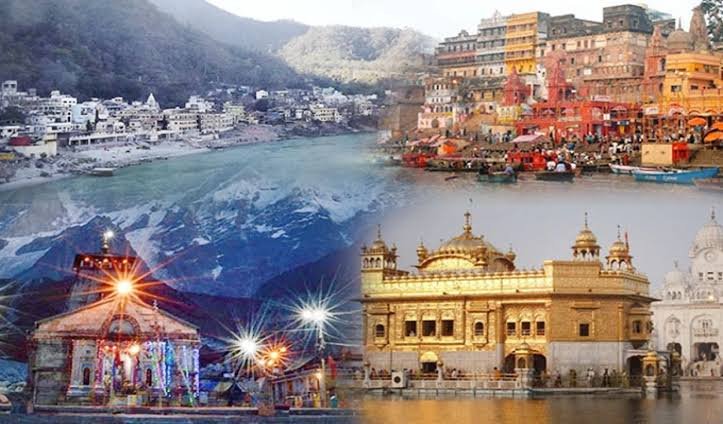Travel Guides & Articles
Hotel giants, ₹1 crore weddings, and Siliguri? Banker spills secrets behind India’s travel boom

India has cracked the world’s top 3 travel destinations for 2025—and investment banker Sarthak Ahuja says what’s happening behind the scenes in hotels, weddings, and luxury chains is even bigger than the ranking.
Citing The Telegraph UK’s 2025 Travel Awards, Ahuja revealed that India ranks just behind New Zealand and Japan as one of the most desirable countries to visit. On LinkedIn, he described the surge as “sudden,” with a ripple effect now reshaping the hospitality sector.
Two Indian hotel brands—Oberoi and Taj—ranked among the top three in the world, alongside Belmond Hotels, owned by the Louis Vuitton group.
India’s rapid ascent is triggering an aggressive expansion. Indian Hotels Company Limited (IHCL), which owns Taj, has opened 50 properties since January and plans to double its portfolio to 700 hotels by 2030. French giant Accor is on track to triple its presence, aiming for 300 hotels in the same timeframe.
Ahuja said India is crossing the $3,000 per capita GDP mark—a threshold at which countries typically see a hospitality boom. But the supply isn’t there yet: India has just 200,000 branded hotel rooms, roughly the same as the UAE, a country with 1% of India’s population.
He pointed to cities like Siliguri, now a wedding hotspot for families from Bihar and Bengal, where major hotel chains like Taj, ITC, and Hyatt are racing to enter. “People are spending ₹1 crore on weddings and there are literally not enough properties with 100 rooms,” he wrote.
With domestic travelers taking three short trips for every one trip abroad, Ahuja called this “an opportune time” for boutique hotels and Airbnb-style operators to cash in.
Travel Guides & Articles
Air India and Air Astana sign codeshare agreement to boost India–Kazakhstan connectivity

Air India and Air Astana, the flag carrier of Kazakhstan, have signed a new codeshare agreement to offer more flight options to travellers.
The codeshare partnership enables cooperation between the two carriers on trunk routes between Kazakhstan and India, covering Air Astana routes operated between Almaty and Delhi, and Almaty and Mumbai. With this, Air India will place its ‘AI’ designator code on Air Astana’s flights to and from India, providing its customers convenient access to Almaty, a rapidly growing tourism and business hub in Central Asia.
Air India customers travelling to Almaty from points beyond Delhi and Mumbai will be able to conveniently travel on a single ticket and check-in their baggage through to Almaty at the point of origin.
Campbell Wilson, Chief Executive Officer & Managing Director, Air India, said “Our new codeshare partnership with Air Astana creates stronger air links to Kazakhstan, a fast-growing market with immense potential for tourism. Beyond serving leisure travel demand, our partnership will also support trade and cultural exchanges between our two countries, while bringing a new destination in Central Asia closer to our customers.”
Peter Foster, the Air Astana Group’s Chief Executive Officer, commented on the codeshare with Air India, “We are delighted to have concluded a comprehensive code share agreement with Asia’s oldest airline. Air India is an exceptionally well-managed business, which operates a comprehensive network of flights to, from and across India, the world’s most populous country and one of the fastest growing travel markets. India is of key strategic importance to the Air Astana Group as we increase flights from Kazakhstan to Delhi, Mumbai and Goa. The code share will accelerate the increasingly strong business, tourist and student traffic flows between our two countries”.
The new arrangement builds on an existing interline partnership between Air India and Air Astana that came into effect earlier in 2025. Under the interline agreement, Air India customers already have convenient connections via Almaty to multiple destinations across Central Asia and China including Astana (Kazakhstan), Bishkek (Kyrgyzstan), Tashkent (Uzbekistan), Dushanbe (Tajikistan) and Urumqi (China). Air Astana enjoys access to 18 destinations across Air India’s domestic network and 9 international destinations via Delhi and Mumbai.
With this step-up to a codeshare agreement, travel between India and Kazakhstan becomes more convenient for customers while also opening a wider network of destinations through a single booking and check-in process.
Subject to regulatory approvals, the codeshare flights will be progressively made available for sale across Air India’s booking channels, including the airline’s official website, mobile app, and through travel agents worldwide.
Travel Guides & Articles
UP launches farm stay scheme for tourism

Uttar Pradesh has introduced a first-of-its-kind farm stay tourism scheme aimed at transforming rural areas into vibrant cultural hubs. The initiative seeks to promote agri-tourism by offering visitors authentic experiences of village life, while also creating income opportunities for farmers and rural communities.
Unlike regular homestays, farm stays under this programme will be developed on or near working farms. Each facility must include at least two lettable rooms, a reception area, and arrangements for immersive rural activities such as farming, dairy work, horticulture, and traditional cooking.
The state’s Directorate of Tourism has opened proposals for investors to develop these farm stays. The scheme provides strong financial incentives including subsidies, reimbursement of EPF contributions for up to five years, and additional support for employers who hire differently-abled workers.
Tourists will get the chance to experience hands-on activities like milking cows, harvesting crops, and enjoying traditional meals with farming families. This not only enhances cultural exchange but also promotes sustainable practices and eco-friendly tourism.
Officials explained that the farm stay initiative is designed to generate rural jobs, empower women, and preserve local heritage. By blending cultural authenticity with modern tourism infrastructure, the project aims to position Uttar Pradesh as a leading agri-tourism destination in India.
With its strong focus on sustainability and livelihood generation, the scheme is expected to boost both tourism and agriculture sectors. The government envisions this model as a long-term driver of rural development, offering travelers a unique glimpse into the everyday life of India’s villages.
Travel Guides & Articles
Pilgrimage travel emerges as fast-growing tourism segment: MMT

India’s tourism sector is witnessing a strong surge in pilgrimage travel, with accommodation bookings across 56 spiritual destinations rising by 19% in FY24-25, according to MakeMyTrip’s latest report. The trend highlights how religious journeys are becoming a major driver of travel demand, spreading beyond traditional hubs into newer destinations.
The report notes broad-based growth, with 34 destinations recording double-digit increases and 15 posting over 25% expansion. Established centres such as Varanasi, Ayodhya, Puri, Amritsar and Tirupati continue to attract large footfalls. Simultaneously, emerging locations like Khatushyam Ji in Rajasthan, Omkareshwar in Madhya Pradesh and Thiruchendur in Tamil Nadu are witnessing rapid growth, signalling a widening spiritual canvas.
Pilgrimage trips are increasingly characterised by short, purpose-led stays. Over half of the travellers (53%) opt for single-night visits, while only 5% extend their stay beyond four nights. Interestingly, more than 63% of bookings are made within six days of travel, underlining the last-minute planning habit typical of Indian travellers.
Group travel is another defining feature. Nearly 47% of pilgrimage trips are booked by families, friends or community groups, compared to 39% in leisure tourism. This collective nature underscores the deeply shared and cultural dimension of spiritual journeys, where religious visits are often seen as community experiences.
Accommodation supply has also expanded rapidly to meet rising demand. Over the past three years, more than one-third of all hotel rooms at pilgrimage centres have been added, along with a sharp increase in homestays and hostels. Premium stays are gaining traction too, with bookings above INR 7,000 per night rising by over 20% in FY24-25.
Interestingly, a growing number of travellers are combining spirituality with leisure. MakeMyTrip found that while 52% of holiday packages were booked exclusively for pilgrimage, nearly 48% blended spiritual destinations with cultural or recreational stops. This dual demand is prompting the industry to innovate, positioning pilgrimage not just as faith-based travel but also as a holistic cultural tourism experience.
-

 Business2 weeks ago
Business2 weeks agoThe Guardian view on Trump and the Fed: independence is no substitute for accountability | Editorial
-
Tools & Platforms4 weeks ago
Building Trust in Military AI Starts with Opening the Black Box – War on the Rocks
-

 Ethics & Policy1 month ago
Ethics & Policy1 month agoSDAIA Supports Saudi Arabia’s Leadership in Shaping Global AI Ethics, Policy, and Research – وكالة الأنباء السعودية
-

 Events & Conferences4 months ago
Events & Conferences4 months agoJourney to 1000 models: Scaling Instagram’s recommendation system
-

 Jobs & Careers2 months ago
Jobs & Careers2 months agoMumbai-based Perplexity Alternative Has 60k+ Users Without Funding
-

 Podcasts & Talks2 months ago
Podcasts & Talks2 months agoHappy 4th of July! 🎆 Made with Veo 3 in Gemini
-

 Education2 months ago
Education2 months agoMacron says UK and France have duty to tackle illegal migration ‘with humanity, solidarity and firmness’ – UK politics live | Politics
-

 Education2 months ago
Education2 months agoVEX Robotics launches AI-powered classroom robotics system
-

 Funding & Business2 months ago
Funding & Business2 months agoKayak and Expedia race to build AI travel agents that turn social posts into itineraries
-

 Podcasts & Talks2 months ago
Podcasts & Talks2 months agoOpenAI 🤝 @teamganassi





















